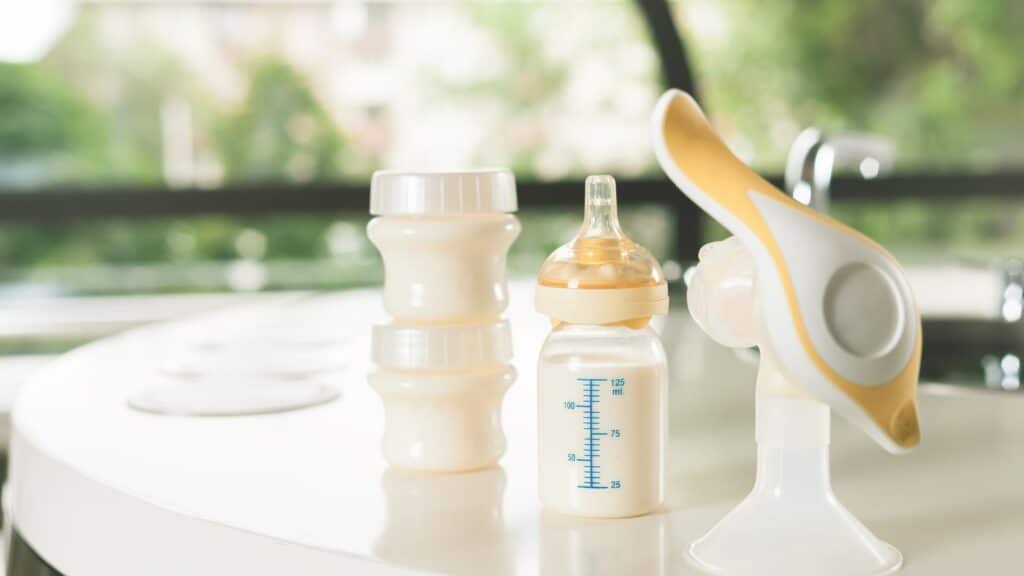Although breast milk is still the best source of nutrition for babies, breastfeeding parents may still choose infant formula to nourish their babies for various reasons.
Switching from breast milk to infant formula may take some time. But once you and your baby get the hang of it, it’s often possible to offer your baby both breast milk and formula simultaneously.
Here are a few tips that can help you with combination feeding.

Mixing Breast Milk and Formula by Combo Feeding
There’s no denying how beneficial breast milk can be for a growing baby. Besides containing the necessary nutritional content, it also contains antibodies that can protect your child from infection. Breastfeeding sessions may even reduce infant death syndrome risk [1].
What’s excellent about breastfeeding is that it can also speed up a parent’s recovery process, especially those who recently gave birth to their first child. It also helps alleviate the effects of postpartum depression by balancing the parent’s hormones.
While the World Health Organization and the American Academy of Pediatrics strongly advise parents to provide breast milk for their child for the first six months from their baby’s birth, everyone knows that it isn’t always the case.
Certain factors can cause a parent to stop exclusive breastfeeding momentarily. Even more, these expectations from parents may eventually lead them to feel burned out afterward, which could cause them to quit exclusive breastfeeding prematurely.
Fortunately, it doesn’t always have to be this case. If parents feel overwhelmed with breastfeeding, supplementing their babies with infant formula is a practical option.
Combination feeding refers to using breast milk and formula alternatively, making it possible for parents to provide proper nutrition for their babies but still offer an alternative option when medical circumstances make breastfeeding impossible.
As you gradually reduce your exclusive breastfeeding sessions, you can begin including formula milk in your feeding plans until your baby becomes well-suited to transition to combo feeding.
Why Parents Choose Combination Feeding
There are many reasons why parents choose to combine formula feeding and breast milk. Let’s take a closer look at why it makes sense to try combination feeding.
You’re Producing Insufficient Milk
If you find yourself struggling to produce enough milk for your growing baby, then you may be able to help boost your body’s supply through proper hydration and nutrition. However, sometimes, even with the mom’s best efforts, your milk production isn’t enough to cater to the baby’s needs. Various reasons, such as medication, age, and hormonal changes, may contribute to breast milk supply issues.
A Mom to More Than One Babies
When you’re a mom of twins or multiple babies, there’s a big chance you won’t have enough breast milk to supply their demands. Often, it’ll leave you feeling depleted even if you’re babies remain insatiably hungry. Combination feeding might offer an excellent solution to your breast milk woes.
You Need Enough Rest
Everyone lives a busy lifestyle these days, especially moms. So, having your partner handle formula feeding can help you get extra sleep. Meanwhile, if you can’t get the help you need at night, you may consider giving your growing baby a small amount of formula milk before bed. Doing so can help alleviate your baby’s hunger a bit longer so that you can get more sleep.
You’re Returning to Work
If you find balancing your work and your exclusively breastfed baby challenging, then it’s best to consider mixing breast milk and formula. For instance, you can consider it in the morning and evenings and then ask your baby’s caregiver to provide baby formula during the hours you’re not at home. Although it may take some time for your baby to adjust, combining breast milk and formula ensures that your baby still gets the nourishment they need to grow.

Steps to Consider When Combo Feeding
Prepare the Formula
If you’re using a powdered or concentrated formula, you’ll need to prepare it based on the packaging’s instructions. Ensure that you add the proper amount of distilled water to mix the baby formula properly.
Once you’ve mixed the water and formula, you can start mixing breast milk in the same bottle. However, it will help to remember not to use it as an alternative to distilled water. It’s best to ensure that you have the right amount of water in the formula before adding breast milk to ensure that it won’t affect the formula’s nutritional content.
Safely Store Both the Breast Milk and the Formula
You can store the breast milk in a food-grade plastic container for half a year. But once it’s thawed, you can let it sit in the fridge for 24 hours before disposing of it. Meanwhile, you can keep freshly pumped milk in the back of the refrigerator for not more than five days or keep it insulated for up to a day (24 hours).
Any opened container of liquid formula should be kept inside the fridge and used within two days (48 hours). If you have prepared formula bottles beforehand, then it’s best to use them within the day. Similarly, a bottle of breast milk and baby formula should be discarded or used within the day (24 hours).
Dispose of Unused or Leftover Milk Supply
Bacteria can start reproducing rapidly on cow-milk-based products. So, always discard any partially used formula or a combination of pumped milk and powdered infant formula beyond an hour.
Also, while room temperature is ideal for human milk for up to 5 hours, a bottle of powdered formula mixed in the same bottle should be disposed of after an hour from the start that you feed your baby.
Mixing Breast Milk and Formula in the Same Bottle
Some parents and caregivers prefer to give formula bottles as part of their baby’s diet. Meanwhile, others choose breast milk over formula to ensure optimum nutritional supply.
But for those who want to start combining formula, it’s best to give your baby two separate bottles of formula feed during, before, and after feeding. You may also consider using a formula scoop and measuring the amount appropriately.
Gradually reducing the feeding also cuts down the chance of developing mastitis. It also gradually reduces the number of breastfeeding, which can be much more convenient for some parents.
Potential Health Risks When You Mix Breast Milk with Formula
Like everything else, mixing breast milk and formula has a few potential drawbacks in the same bottle. Here are a few consequences to help you make the right choice.
You’re Potentially Wasting Breast Milk and Formula
Many fathom the idea of mixing formula with breast milk as they see it’s a waste of “liquid gold.” Although combining it with infant formula is a practical way to alleviate a person’s poor milk supply, bottle feeding with mixed formula can go to waste if your baby doesn’t finish their bottle. So, consider giving them a separate bottle of formula and breast milk afterward if you feel they’re still hungry.
It May Affect Your Milk Supply
Adding formula to your baby’s diet to mimic breast milk can still cause your milk supply to reduce. So, consider mixing it with powdered milk formula to help you with your low milk supply.
Probably Health Risks
Even if you mix breast milk with formula, always follow the label’s instructions. As mentioned, don’t substitute breast milk for distilled water when combining both for bottle feeding. Neglecting to do so could potentially cause adverse effects on your baby’s health.
Get the Right Assistance When Mixing Breastmilk and Formula Bottle
If you have any concerns with mixed feeding, it’s best to ask for help from a professional. Coordinating with your midwife, lactation consultant, or your baby’s doctor can help you with any of your concerns, especially concerning your baby’s body.

The Bottom line
A formula bottle and breast milk don’t have to be mutually exclusive. Remember that a baby’s diet can still thrive on breast milk, expressed milk, or a combination of both.
Always read the manufacturer’s instructions when preparing your baby’s bottle to ensure optimum nutrition. You can either give the bottle early or bottle feed your baby using a separate bottle and see which one works for you.
Just remember to determine how much formula to use separately to prevent diluting the formula or giving your baby an upset stomach.
I hope this article helped you learn a few things about this topic. Let us know in the comments if you have any questions.



